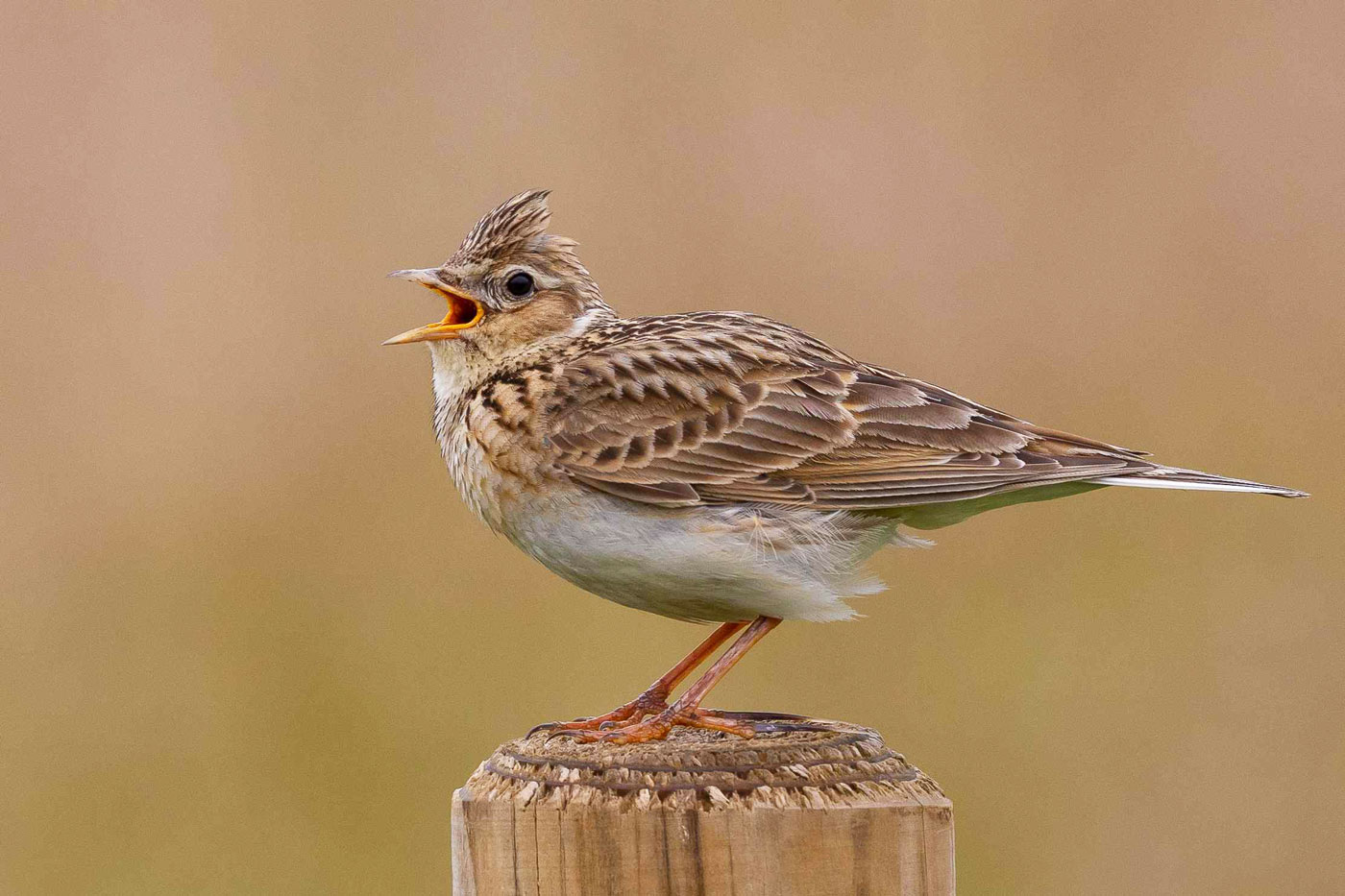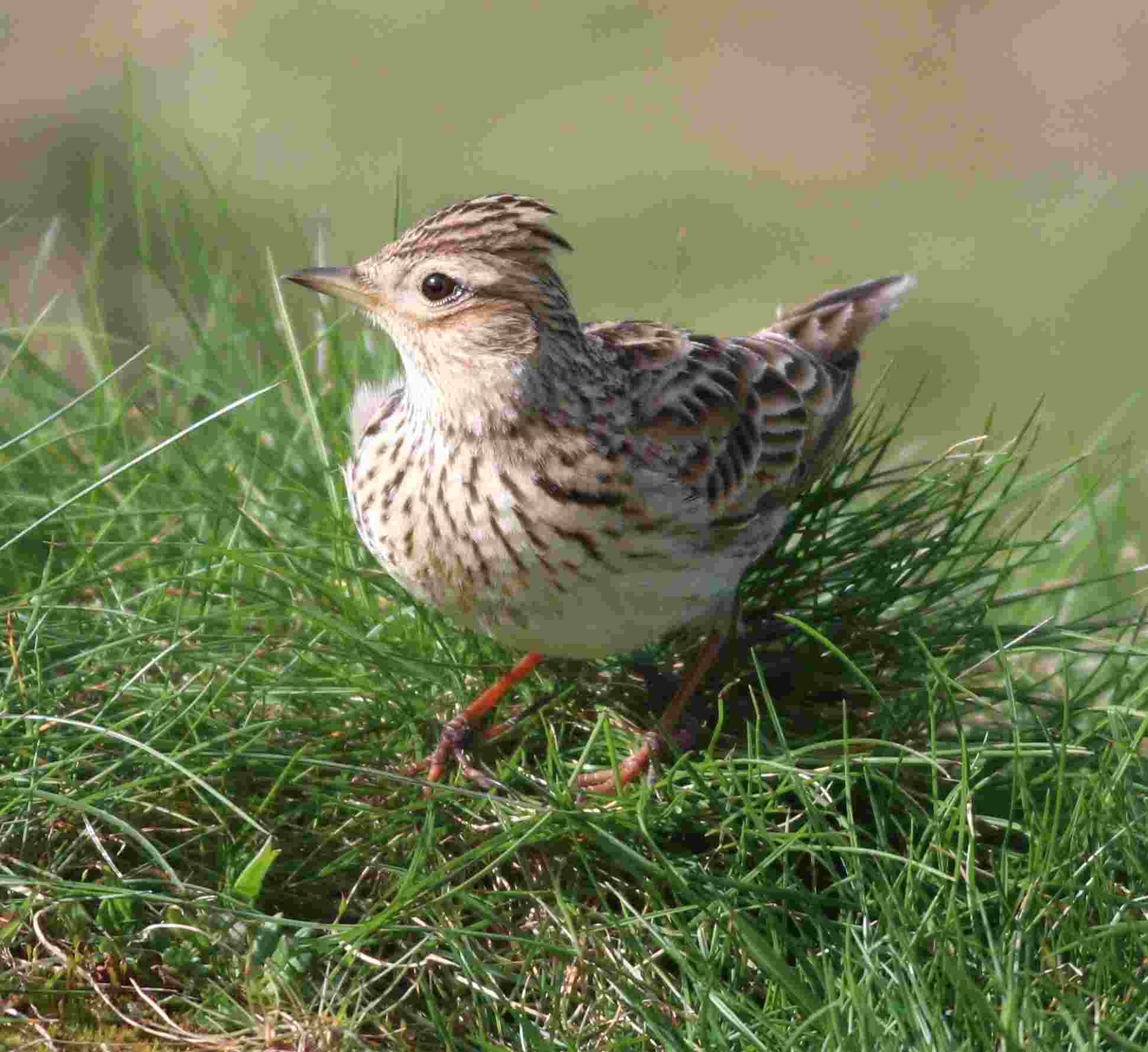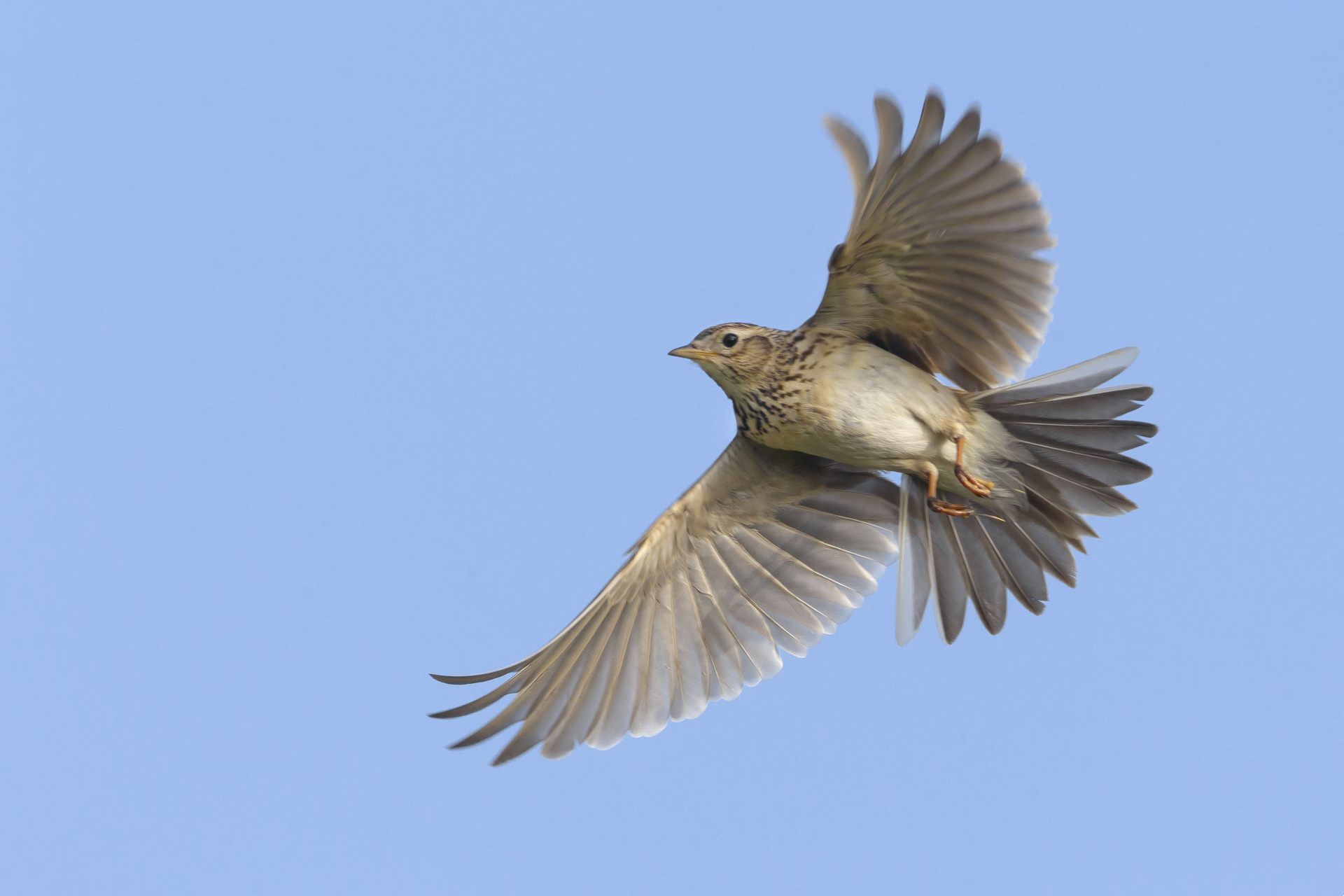If a single bird could be held responsible for sparking my interest in nature it would probably be a Eurasian Skylark singing over Farlington Marshes, Hampshire, one sunny day in May, many years ago. Before this encounter, I had only the vaguest awareness of what a lark even was, but I was treated to a virtuoso performance as this bird rose, plateaued, then hovered, its wings beating rapidly, while it issued a constant stream of notes. And this was taking place within walking distance of my home!
Judging by the number of poets and composers who have seen skylarks as a suitable subject for their compositions, I was clearly not the first to be moved. Although an "incessant outpouring of rolling, chirruping and whistling notes delivered quickly" is as good a description of its song as any I've read, no words can really do it justice. Perhaps the violin cadenza of Ralph Vaughan Williams's The Lark Ascending is the closest human impression. The song is delivered by males and typically last for about five minutes, though half-hour marathons are not unknown. It may be delivered on the ground or in the air, up to 200 m up, although 50 m is more common.

Despite being one our most celebrated songsters, Eurasian Skylark is rapidly declining in the UK (Tony Brown).
A long decline
Sadly, this iconic bird is nowhere near as familiar as it once was. Eurasian Skylark breeds in a wide range of open habitats, with territory density in the UK greatest on coastal marshes, then – in order of descending density – heathland, natural grassland, arable farmland, moorland and pastoral farmland. Although arable farmland does not support the highest densities, it is the single most important habitat simply on account of its great extent. Within this there are significant density differences between cereals, root crops, legumes, cabbages and turnips, for example. Because of the huge area given over to cereals, though, this is the single most important area of concern.
In the UK, declines probably began in the 1950s, although they accelerated sharply in the late 1970s. Between 1968 and 1995, the total number of breeding birds halved from 6 million to 3 million. In arable countryside, where the bulk of the UK population is, observations in the late 1970s showed that Eurasian Skylarks were changing their winter diet – away from seed and towards the green shoots of autumn-sown cereals. The BTO has speculated that this may have been an early warning of food shortages; with less winter stubble and a greater use of herbicides, fewer weed seeds were available.
Additionally, it is known that breeding birds desert autumn-sown crop fields when the sward reaches a critical height in spring – and this happens well before the end of the breeding season. In addition to preventing nesting, tall crop development influences where the birds place their nests. As the crop grows taller, they are forced to nest closer to vehicle 'tramlines', which are also used by predators such as foxes; consequently, predation rates are higher.

Eurasian Skylark is renowned for its display flight, in which the male rises vertically from the ground high into the air, where it remains stationary for several minutes on fluttering wings before parachuting back down to the ground (Steve Young).
The decline continued into the new millennium, as shown by Breeding Bird Survey data. Between 1994-96 and 2007-09 the fall was most severe in Northern Ireland and eastern England. Overall across the UK, for every 100 birds in 1978 there were just 36 in 2018, though there seems to have been a very small uptick in recent years.
The Pan-European Common Bird Monitoring Scheme cites a 56% decline in European numbers in the period 1980-2019, with a 12% fall between 2010-19. Although the overall decline mirrors our own, the decrease since 2010 has been more rapid than that in the UK, suggesting that continued agricultural 'modernisation' – which started later in parts of continental Europe – is still impacting the species negatively. It is easier to estimate the percentage population change than the actual size of the European population, which in 2000 BirdLife International put at between 25-55 million, a huge range of values.
Unbelievable numbers
Eurasian Skylark is a migratory species across much of Europe. Millions of birds breeding as far north as Finland and as far east as western Russia migrate to the south-west or west through central Europe, the Low Countries and Britain to France, Italy and Spain, some even ending up in north-west Africa. But as the species' numbers have declined, so have its migratory movements.

Wanstead Flats in east London has become an unlikely haven for a small population of skylarks due to the hard work of local volunteers (Tony Brown).
It is worth looking at some historic movements and comparing them with their modern equivalents. Henry Seebohm (quoted in Donald 2004), wrote in the 1880s that: "The rush of Sky-Larks that land on our eastern coasts in autumn is almost past belief. Towards the end of October, or during the first week of November, the number that pass over these marshes [the north coast of The Wash, Lincolnshire] is enormous. When the migration is on, you may see the great army of birds passing at a moderate height for days together …". On the North Sea island of Heligoland, Arthur Butler, writing in the following decade, suggested that the 15,000 caught there on a single night did not even represent "one for each 10,000 individuals of such a migrant stream". Much more recently, in 1959 it was estimated that 360,000 passed over London between 30 October and 2 November; almost certainly these now-unthinkable numbers were mostly birds from the Continent.
Skylarks are generally monogamous, although extra-pair mating is relatively common. They usually return to the same territory and keep the same mate in successive breeding seasons.
Probably originating on the steppes of eastern Europe and Central Asia, they have adapted for life on arable farmland. This, along with open downland, heaths and dunes, is their primary habitat in the UK. However, although these environments are extensive in this country, Eurasian Skylarks are pretty choosy about exactly where they nest: it has to be on the ground in vegetation between 20-50 cm tall, where the plant growth is open enough to provide easy access to the ground. They also require vegetation of less than 25 cm for feeding and prefer incomplete ground cover. Additionally, they usually do not nest within 10 m of trees, tall fences or hedgerows.
Breeding adults make two or three nesting attempts between April and August. The time from egg laying to fledging is remarkably short, befitting a bird that breeds in an environment that may be trampled, burned or cut. Typically, four eggs are incubated by the female and hatch after 11 or 12 days. On average, the young leave the nest when they are just eight days old, although they still depend at least in part on being fed by their parents. They can fly and feed themselves after another 10 days.

Decreases in the UK reflect the species' decline across Europe; it is listed as threatened on the national Red lists of Belgium, Germany, Ireland and The Netherlands (Daniele Occhiato).
Adults feed mostly on the seeds and leaves of 'weeds' and crops, but the chicks are fed exclusively on protein-rich insects and spiders for the first week of life, with invertebrates also forming an important part of adults’ diet from April to August. They don't necessarily feed close to the nest, often flying over other larks' territories to access good supplies. The defended territory may be a small area, but the birds require a larger area to provide enough food for themselves and their new family.
Agricultural intensification is the biggest factor in Eurasian Skylark's decline. In the UK, this means especially the change from spring to autumn sowing of cereal crops, which reduces the number of possible breeding attempts and eliminates winter stubbles for feeding. One of the problems with winter wheat is that it usually grows too tall and dense to allow more than one brood. To this can be added the loss of mixed farmland and rotational cropping, and the widespread use of herbicides, which eradicate 'weeds'. Put together, this means not enough young birds fledged every breeding season, and not enough food for the adults in winter. On the Continent, an additional problem has been hunting.
A local success story
At the end of the road where I now live, in the heart of east London, is the semi-acid grassland of Wanstead Flats. There, areas of unmown grass sit cheek by jowl with patches of broom and brambles. Several pairs of Eurasian Skylarks still nest in the tussocky grass and feed on the shorter sward of the tracks running through it, the football pitches nearby and even the mown grass of the adjacent model aircraft runway. It is definitely 'sub-optimal' habitat. In many ways it defies belief that this, the closest population of the species to central London, can survive here at all.
There is no winter wheat and no spraying with herbicides, but there are plenty of other problems. Until last year, although people were asked to keep to the tracks and dog-walkers to keep their animals on the leash, it was still a common sight to see canines rampaging through the area. Grass fires are common in summer. There is the regular drone of a model aircraft looping the loop overhead. And, before the end of the football season, desperate defenders or wayward strikers often send footballs into the grass.
With an annual footfall of more than 500,000, this is a site where disturbance is spelt with a capital D. There are large populations of foxes, rats and corvids, all known predators of eggs and young, along with less expected threats; I have seen a Black-headed Gull repeatedly attacking a song-flighting male.
For more than a decade, local campaigners worked with the City of London Corporation, which manages the site, to find a solution. A cutting regime, whereby 20% of the breeding habitat was mown each autumn to prevent scrub encroachment, seemed to stabilise the population for a few years, but from 10 singing males a decade ago, the figure had fallen to just three in 2020. Drastic measures were needed.

This colour-ringed bird, photographed at Crosby, hails from a local ringing scheme in Lancashire, in which birders tagged the larks on their nesting areas to see how far they travelled; most moved to the close-by coast (Steve Young).
In spring 2021, 9 ha of the breeding habitat was enclosed with plastic mesh fencing, and 40 volunteers were mobilised to engage with people, especially dog-walkers, to win support for the scheme. The public were far more supportive than I could have imagined, even in my wildest dreams. Human and canine disturbance was effectively eliminated and at least two young Eurasian Skylarks (possibly four) fledged.
Added bonuses were a midsummer singing Common Quail in the enclosed area, and less disturbance of our regular passage migrants, Northern Wheatears and the like. In late January 2022, males began to sing again, and hopes are high for the season ahead. But, much as we want to keep our East End larks, this population is insignificant in the big scheme of things.
Hope springs
Projects elsewhere give real cause for optimism, though. One such is Hope Farm, Cambridgeshire, which the RSPB bought in 2000. Initially, only wheat and oilseed rape were grown, but a new rotation regime was introduced on its 161 ha, comprising winter wheat, spring barley, winter beans, winter linseed and spring millet.

The RSPB's Hope Farm in Cambridgeshire uses wildlife-friendly agriculture to benefit a wide range of species, including Eurasian Skylark, while still turning a profit (Andy Hay).
By leaving two 16-square-metre 'skylark plots' unsown per hectare in the winter cereal fields, the farm has lost only about £7 worth of crops per plot but has increased Eurasian Skylark productivity dramatically. In 2000, there were 10 breeding territories and average numbers on site the following winter were 18. Those figures rose to 32 territories in 2019 and 48 wintering birds in February 2020. Other species, including Yellowhammer, Common Linnet, Reed Bunting and Northern Lapwing, have benefitted as well. And, importantly, the farm is not run as a nature reserve but as a profitable arable concern, albeit a nature-friendly one.
The big challenge is to reverse Eurasian Skylark decline in its core arable habitat, and for this to happen there needs to be a much greater commitment on the part of government – which needs to really listen to ecologists – and for a culture shift by the arable farming industry along the lines of Hope Farm. If these things happen, plenty of other wildlife besides Eurasian Skylark will be the beneficiaries.
References
BTO species profile, https://www.bto.org/understanding-birds/species-focus/skylark.
Donald, P F. 2004. The Skylark. T & A D Poyser, London.
RSPB Hope Farm. 2020. https://www.rspb.org.uk/our-work/conservation/conservation-and-sustainability/farming/hope-farm/
Seebohm, H. 1882-85. A History of British Birds. R H Porter, London.
Svensson, L, Mullarney, K, Zetterström, D. 2009. Collins Bird Guide (second ed). HarperCollins, London.
Tucker, G M, Heath, M F, Tomialojc, L, and Grimmett, R F A. (1994). Birds in Europe: their conservation status. BirdLife International, Cambridge.
Wilson, J D. 1997. Territory distribution and breeding success of skylark Alauda arvensis on organic and intensive farmland in southern England. Journal of Applied Ecology 34: 1,462-1,478.


